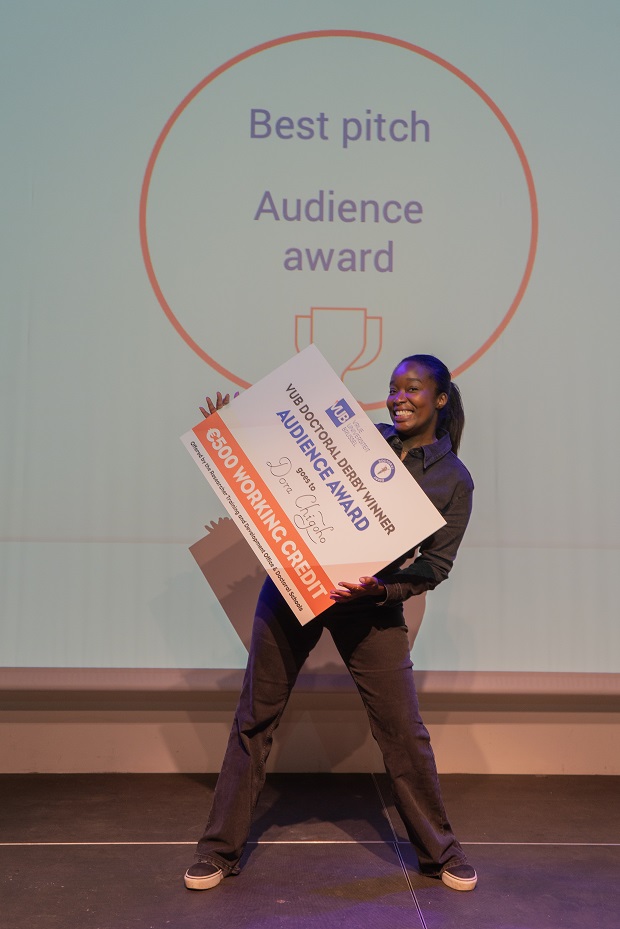- Daily & Weekly newsletters
- Buy & download The Bulletin
- Comment on our articles
Doctoral Derby: Three VUB researchers awarded in university’s science communications contest
Communicating a complex scientific topic in an engaging and accessible way is an increasingly key skill for researchers.
That’s why Vrije Universiteit Brussel (VUB) stages a Doctoral Derby as part of a training programme for its 2,000 PhD researchers. The initiative aims to hone additional skills for the scientists’ future careers.
“Keep it short, write compellingly, and don’t exceed the 200-word mark,” were the instructions for the 27 entrants at the beginning of the three-month process. They then participated in training and feedback sessions as well as video recording before nine finalists were selected.
The final candidates were invited to present their doctoral projects in front of an audience of more than 200, including online spectators, at the finals on 21 May.
Hannelore Geeraert won the jury award for best pitch, the audience vote went to Dora Chigoho and Jara Salueña took home the prize for the best written research summary.

From broccoli to bioplastics
Hannelore Geeraert (pictured above) from the Physical Chemistry and Polymer Science research group confidently stepped onto the stage first. The lack of supportive slides – almost a given in science – could have put her in a vulnerable position. But the ‘less is more’ approach worked in her favour. Armed with broccoli and soup in a plastic container, she grasped the audience’s attention with her talk on bioplastics, ‘Can you imagine life without plastics?’
The problematic topic concluded with a message of hope. Scientific jargon such as polyhydroxyalkanoate or PHA, was illustrated by examples, comparisons and imagery, including “oceans turn into plastic soup”. This enabled her to strike the perfect balance between science and outreach. Also important in her presentation was explaining the researcher’s role: “By demystifying this link between composition and properties, we strive to unlock the full potential of PHA bioplastics and pave the way for a more sustainable future.”
On receiving the €500 research award from the six-member jury, Geeraert said: “I am very excited to spend the prize on some nice tools to teach people of all ages and backgrounds about the fascinating world of bioplastics.”

Let’s keep it kidney-friendly
A clear winner emerged in the public speaking contest. Dora Chigoho (pictured above) from the Molecular Imaging & Therapy research group accepted the audience award with a smile. Again, her presentation adopted a minimalistic approach with “Who doesn’t like alpacas?” accompanied by just one photo of the cute animal.
But did you also know that alpacas make a special type of antibodies that can be engineered into nanobodies, which are 10 times smaller but just as effective? And that tiny nanobodies, thanks to their small size, can easily and quickly find hidden targets in the body, such as cancer cells? In her research, Chigoho tries to better understand the behaviour of nanobodies – not only in the whole body but also in the kidney and at a microscopic level within kidney cells. Hence the title of her presentation, ‘Using alpacas’ antibodies to fight cancer: let’s keep it kidney-friendly'.
"Participating in the Doctoral Derby was an eye-opening experience,” Chigoho commented after the finals. “It allowed me to sharpen my science communication skills and connect with a broader audience,” she added, also thanking the training programme and the audience for their support and encouragement.
Fungi to grow the future
The third prize was awarded for the best written research summary. After some deliberation, the jury awarded the honour to Jara Salueña from the Microbiology research group.
Here’s her written entry on the potential of fungi:
“Do you ever stop to consider the materials around you? The chair you sit on, the insulation in your home, your favourite leather jacket? Pretty soon, these may all be made from fungi. Fungal materials are as pliable as wood without deforestation and as smooth as leather without animal harm. Like the roots of a tree, most fungi grow underground as a giant network called mycelium, some up to 10 square km in size! This abundant natural resource is biodegradable and can be grown on waste to produce sustainable materials. However, in order to make things out of mycelium, we first need to learn how to produce it in a uniform way. Growing each batch of mycelium results in materials with unique characteristics. I research the conditions needed to produce consistent materials by growing them under different temperatures and lights. By adjusting these factors, we can personalise the properties of mycelium materials with different strength and durability for different applications. With this knowledge, factories can produce uniform mycelium materials for a variety of everyday uses. Join me in paving the way towards a future where innovation and sustainability go hand in hand, one mycelium jacket at a time.”
The Doctoral Derby process included the recording of a video pitch for the Science Figured Out platform. The results will be broadcast later this year.
Photos: Tim Oosterlynck














